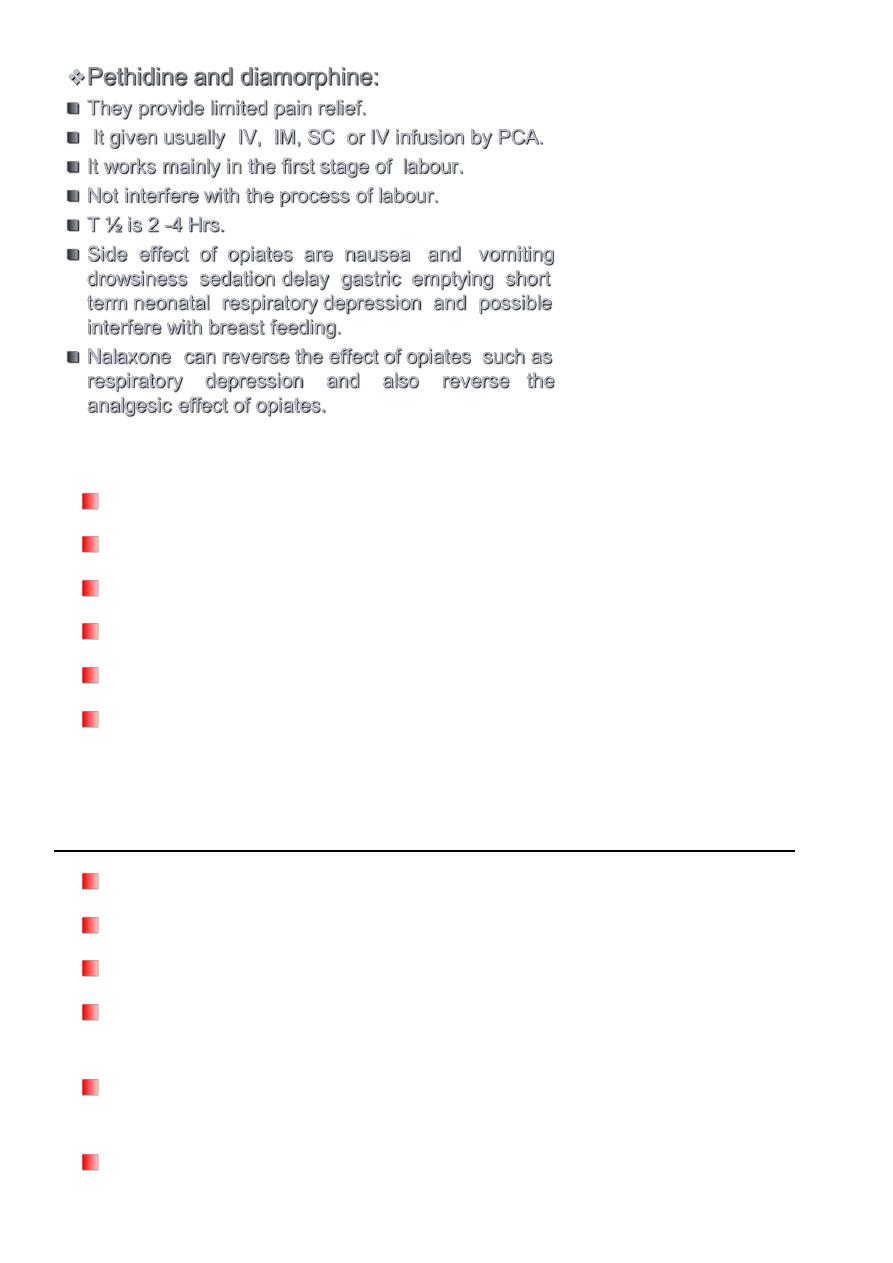
1
Forth stage
Obstetric
Lec-2
.د
هبة
1/1/2112
Obstetric analgesia and anesthesia
The major objectives of obstetric analgesia and anesthesia include:
1- Pain control during labour and delivery that is safe for mother and fetus
2- Anesthetic management during cesarean delivery that does not harm the mother or
the neonate.
3- Assisting the obstetrician with blood pressure and heart rate of complicated
pregnancy and with the management of comorbidities during labour.
Labor pain in the first stage
Uterine contractions leading to : myometrial ischemia. The pain felt through
hypogastric plexuses , pre aortic plexuses to spinal cord through (T10-L1).
Cervical dilatation and stretching Sensation pass through nerve entering to sacral
root.
At this stage this pain is visceral pain, diffuse, poorly localized, in lower abdomen
radiated to the back.
Labor pain in the second stage
Uterine contractions
Pressure on the pelvic floor structures .
Stretching of the perineum
The last two felt through pudendal nerve (S2, 3, 4) .
This pain is somatic pain so its well localized.
Pain control
Analgesia
o non pharmacological
o pharmacological
parenteral
inhalational

2
Anesthesia
o General anesthesia
o Regional anesthesia
spinal
epidural
o Regional block
Pudendal
Para cervical
Analgesia:
Analgesia refer to pain relief not involve the removal of complete sensation it is include:
1-non pharmacological
Effective in relieving mild pain
o Massage.
o Homeopathy.
o Acupuncture.
o Hypnosis.
o Emotional support.
o Transcutaneous electrical nerve stimulation TENS work by block pain fibres in
posterior ganglia of the spinal cord by stimulating small afferent fibres the (
gate theory ) it does not reduce pain score.
2- Pharmacological analgesia
Ideal analgesia should be:-
o Easily administered.
o Rapid onset of action.
o Provide good analgesia.
o No or low side effect on both mother and fetus.
o No effect on the process of labour ( not affect uterine contraction or pelvic
floor tone)
o Parenteral ( Opiates)

3
Fentanyl
More potent synthetic analgesia .
Easily administered ( parenteral ).
Rapid onset.
Short duration of action
Cross placenta and cause neonatal complications.
Side effect GIT ( nausea , vomiting , delay gastric emptying and
constipation ),CNS ( confusion ) and respiratory depression.
Inhalational analgesia Nitrous oxide NO mixed with oxygen Entonox has:
Quick onset.
Short duration of effect.
More effective than pethidine.
It used for short duration latter on in labour or while awaiting for
epidural analgesia.
Side effect include nausea light headache and not suitable for prolonged
use.
Excreted through the lung.

4
Epidural (extradural) analgesia and anesthesia
Play important role in obstetrics.
The decision to have it should be combined between woman obstetric
team and anesthetist.
Is injected into the epidural space between L2 - L3 or L3-L4.
It necessitates a block from the T10 to the S5 dermatomes
A test dose is given to confirm the catheter position, if no unwanted
signs is observed after 5 min of injection, a loading dose can be
administered.
The main indications
1) Effective pain relief.
2) Prolonged labour.
3) Hypertension.
4) Multiple pregnancy.
5) Certain medical disease (cardiac disease).
6) High risk of operative delivery
The main contraindication:
1) Coagulation disorder.
2) Local or systemic sepsis.
3) Hypovolaemia.
4) Insufficient numbers of trained staff.
5) Patient refusal.
Complications:
Maternal Complications:

5
1) Accidental dural puncture causing post dural headache due to leakage
of CSF mainly in the top of the head and relieved by lying flat treated by
injection of autologous blood patch in the epidural space.
2) Accidental total spinal anesthesia injection of local anesthetic drug in
subarachnoid space.
3) Hypotension treated by IV bolus isotonic solution vasopressor
phenylephrine.
4) Respiratory failure.
5) Loss of consciousness.
6) Death intubation ventilation circulatory support delivery.
7) Spinal haematoma.
8) Drug toxicity (injection in to blood vessels).
9) Bladder dysfunction over distension catheterization.
10) Hypotension un common here but more in spinal anesthesia .
11) Cardiac arrest.
Fetal complications
1) Fetal compromised if maternal hypotension developed.
2) Short term respiratory depression of the baby because of using opiates
in epidural solution which is a mixture of low dose local anesthesia
bupivacaine and opiates fentanyl.
Anesthesia
Anesthesia refer to rendering the patient completely insensate to
pain it is either general or local Combined spinal epidural analgesia has the
advantage of producing rapid onset and provision of prolonged analgesia.
1) Regional anesthesia involve administration of local anesthetic to render
specific part of body insensate In obstetrics it consist of spinal and epidural.

6
Spinal anesthesia:
Drug here small volume of local anesthesia inject into subarachnoid
space.
It considered more effective.
Faster onset.
Indications anesthesia for :
1. Caesarean section.
2. Trial of instrumental delivery in theatre.
3. Manual removal of placenta.
4. Repair of difficult vaginal or perineal tear.
5. Used when GA are contraindicated
It is not used for analgesia in labour.
Complication for spinal anesthesia:
1- Headache.
2- Convulsion (rare).
3- Blindness (rare).
4- Hypotension.
5- Bradycardia.
6- Injury to spinal cord.
7- Hematoma.
8- Infection.
9- Retention of urine
10- Fair of technique.
Contraindication :
Hypovolemia.
Clotting disorders.

7
Septicemia.
Aanatomical deformities.
Neurological disease.
Patient refusal.
Epidural Anesthesia
In cesarian delivery, a block extending from the T4 to the S1.
2) General anesthesia given IV or inhalation to render patient unconscious
and all body insensate.
Indications of GA.
1. Emergency CS
2. When regional anesthesia is contraindicated.
3. Mother prefers.
4. A prolonged surgery.
5. No available staff for regional anesthesia.
Risks of GA.
1. Aspiration of gastric content.
2. Neonatal depression.
Regional blocks:
1) Para cervical block the innervation of the uterus and cervix injection of
LA submucosally in to the fornix of vagina laterally to cervix It
effect only first stage of labour D and C analgesia It can cause fetal
bradycardia.
2) Pudendal block Somatic pain of second stage of labour transmitted via
pudendal n., it involve injection of local anesthetic below the ischial

8
spines ( the approximate location of the pudendal nerve ). This
block is administered in:
Second stage of labor.
Operative delivery.
Suturing of perineum following delivery.
